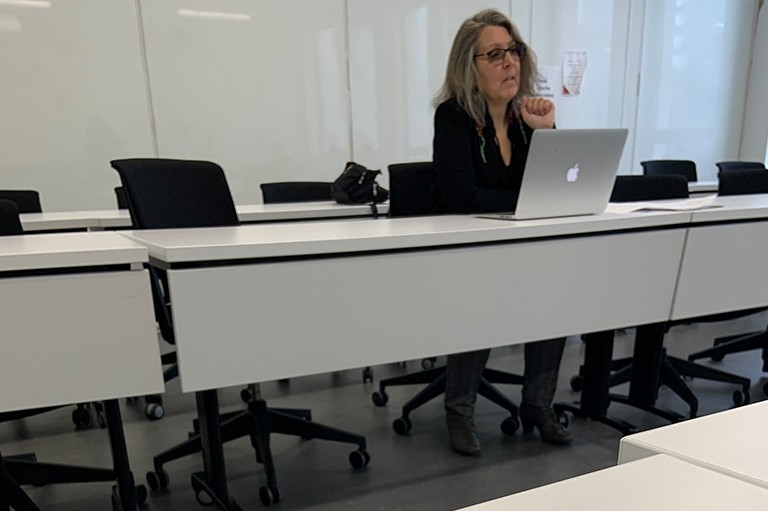Concordia offers a non-credit workshop on Cree language and culture
 Manon Tremblay, senior director of Indigenous Directions, teaches Plains Cree during the lunchtime workshop.
Manon Tremblay, senior director of Indigenous Directions, teaches Plains Cree during the lunchtime workshop.
Manon Tremblay is no stranger to teaching Cree, but she wanted to try a new approach.
This winter, she offered a non-credit Cree language workshop as part of Concordia’s annual Pîkiskwêtân Indigenous Learning Series. Her goal was to create an informal, interactive environment as opposed to a structured course focused on grammar and vocabulary.
“The idea behind the workshop was to provide some insight into Cree culture and traditions through language,” explains Tremblay, senior director of the university’s Indigenous Directions. “Learning a language without any insight into the cultures and the traditions of the people who speak it can be awfully dull and dry.”
A nêhiyaw-iskwêw (Plains Cree) from the Muskeg Lake Cree Nation, she taught her own language, nêhiyawêwin, the Cree dialect spoken in Saskatchewan and westward.
Participants in the first-of-its-kind workshop included undergraduate and graduate students, faculty and staff. The sessions were held weekly during the lunch hour, and participants were free to eat while learning.
“It is so important for Indigenous languages to be taught, spoken and preserved,” says First Peoples studies student Aidan Condo.
“As a Mi’kmaq person, I was curious to learn the similarities and differences between our languages since they are both part of the Algonquian language family. I only have a basic level of understanding of my own language, yet I was able to notice connections between certain words.”
Eli Friedland is an advisor for institutional equity and recognition initiatives in Concordia’s Office of Research with a background in languages. Having grown up in Saskatchewan, he says he could not pass up the opportunity to learn Plains Cree.
“It is the most common Indigenous language spoken where I grew up. I learned a few words just by hearing them often when I was younger, but I never understood beyond that,” Friedland notes.
“When I saw the open invitation for an introductory class to the language, it was irresistible.”
 From left: Aidan Condo and Eli Friedland
From left: Aidan Condo and Eli Friedland
Teaching a complex language in a casual setting
Tremblay relates that the complexity of the language is partly what inspired her to try an unconventional format to teaching it. Infusing lessons with storytelling and connecting words to history helped participants grasp challenging linguistic concepts while gaining insight into Cree culture.
“Cree people have a rich culture and numerous sacred stories that are actually quite funny but have valuable life lessons built into them,” she shares.
“Using some of these stories to teach the language keeps learners interested. Cree is a polysynthetic language,” Tremblay explains, meaning that it’s highly inflected.
“It gives Latin a run for its money when it comes to the number and complexity of declensions and inflections. This can be overwhelming for learners and why I felt it was important to keep the workshop interactive.”
This approach resonated with both Condo and Friedland.
“The informal workshop setting fostered a learning environment that encouraged community, sharing and storytelling, which allowed us to learn much more than just language,” Condo says.
Friedland calls Tremblay a gifted teacher and linguist.
“She knew that most of us needed to make blunder after blunder before we could even say tânisi (how are you? / hello) or pêyak (one),” says. “In the informal setting she could keep the class as a space of pure encouragement, which I appreciated.”
One example of teaching language through history is a story Tremblay shared about the origin of the Cree word for pig. French settlers first introduced pigs to the land and would call out to their pigs by yelling “coche, coche, coche!” from the shortened French word cochon.
As there had been no pigs in the land prior to the arrival of the settlers, there was no Cree word for them. A new Cree word took shape, kôhkos, based on the familiar settler call out.
“Why Cree people who lived in the Northwest were borrowing from French rather than English, well, that’s another integral part of Canada’s history,” Tremblay explains. “It is directly related to the territorial expansion of the Northwest Company, a fur trading company that operated between 1779 and 1821 and employed mostly French-Canadian voyageurs.”
Lifestyles and kinship structures revealed through language
Condo observes that some of the differences in the Cree and Mi’kmaq languages reflect the different lifestyles of their people.
“What I enjoyed the most was learning about the origins of certain words, which were often embedded in stories that revealed more about the history, beliefs and way of life of the Plains Cree people,” Condo says.
“It was fascinating to see how many Cree words don’t exist in the Mi’kmaq language, and vice versa, which is largely due to the differences between plains and coastal lifestyles.”
One aspect of Cree that adds to its complexity is how words demonstrate relationships. While a single word is used in English or French for nouns that indicate kinship, for example, there may be several words that reflect context, relationship and gender.
“There are so many root words that can only be completed by specifying to whom or to what someone or something is connected to,” Friedland notes.
“In English, for example, you can speak of an abstract ‘mother.’ In Cree you have to specify nikâwiy (my mother), kikâwiy (your mother) and so on. That seems to me to mirror life in a very concrete way.”
For Tremblay, the workshop was a resounding success, with interest from across the university and many requests for it to be offered again, perhaps online or at Loyola Campus. “I certainly would love to see the same kind of workshop offered in other Indigenous languages in the near future.”
Discover resources and events related to Indigenous History Month at Concordia.




